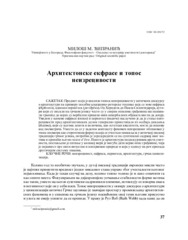Arhitektonske ekfrase i topos neizrecivosti
Architectural Ekphrases and The Topos of Ineffability
Članak u časopisu (Objavljena verzija)
Metapodaci
Prikaz svih podataka o dokumentuApstrakt
Predmet eseja je analiza toposa neizrecivosti u antičkom diskursu o arhitekturi na primeru posebne književno-retorske tehnike koja se zove ekfrasa (ékphrasis), odnosno periegesa (periḗgēsis). Od Herodota do Pavla Silentijarija, autori koji su pisali na grčkom jeziku često su u svojim opisima građevina naglašavali granice do kojih su verbalni prikazi ovih neverbalnih objekata mogli da dopru. Uvidom u njihove ekfrase (opise) i periegese (vodiče) zaključeno je da je stanje neizrecivosti pred arhitektonskih delom generalno proisticalo iz osećaja divljenja (thaûma), koji su njegova lepota i veličina, kao estetski kvaliteti, mogle da izazovu kod posmatrača. Umesto da se u zadatom kontekstu fenomen neizrecivog oblikovan u topos posmatra kao stereotipna formula koja se učestalo ponavljala u antičkoj pisanoj tradiciji grčkog jezika, potrebno je usredsrediti se na suštinski sadržaj ovog motiva i pronaći njegov raison d’être. Pošto je arhitektura nediskurzivna vrsta umetnosti, postavljeno je pita...nje u kolikoj meri je moguće dati veran opis građevine, čija je pojavnost pre svega vizuelne i nepojmovne prirode i koja u odnosu na reč pripada drugačijem sistemu znakova.
This paper analyzes the topos of ineffability in the ancient discourse on architecture, particularly in
the field of poetico-rhetorical techniques known as ekphrasis (ékphrasis) and periegesis (periḗgēsis). From
Herodotus to Paul the Silentiary, the authors who described buildings in their works quite frequently empha sized the limit which verbal representations of these nonverbal objects could reach. An insight into their
ekphrases (descriptions) and periegeses (guides) leads to the conslusion that the state of ineffability in front
of an architectural object generally came from the feeling of wonder (thaûma), which could be provoked
in the spectator by the aesthetic qualities of its beauty and size.
Although the topos in question in Greek tradition found its most sublime use in the negative theology,
it was not until the 2nd century A.D. that this topos, applied to architectural phenomena, was fully developed
in the works of Pausanias, Aristides, and Lucian. The utili...zation of this formula in the descriptions of buildings
continued in the ancient Greek world despite changes of politico-historical periods and transition from
polytheistic to monotheistic model of religion. Instead of observing the phenomenon of ineffable formed as
a topos or a stereotypical formula which periodically appeared in the Greek written tradition, it is necessary
to focus on the essence of this motif and to find its raison d’être. Because architecture is a nondiscursive form
of art, the proposed question is to what extent it is possible to give a faithful description of an architectural
work, whose appearance is primarily of visual and nonconceptual nature and wich belongs to a system of
signs different from words.
Ključne reči:
neizrecivost / ekfraza / periegeza / arhitektura / topos / grčka civilizacija / ineffability / ekphrasis / periegesisIzvor:
Letopis Matice srpske za likovne umetnosti, 2017, 45Izdavač:
- Novi Sad: Matica Srpska
Kolekcije
Institucija/grupa
IFDTTY - JOUR AU - Ćipranić, Miloš PY - 2017 UR - http://rifdt.instifdt.bg.ac.rs/123456789/2371 AB - Predmet eseja je analiza toposa neizrecivosti u antičkom diskursu o arhitekturi na primeru posebne književno-retorske tehnike koja se zove ekfrasa (ékphrasis), odnosno periegesa (periḗgēsis). Od Herodota do Pavla Silentijarija, autori koji su pisali na grčkom jeziku često su u svojim opisima građevina naglašavali granice do kojih su verbalni prikazi ovih neverbalnih objekata mogli da dopru. Uvidom u njihove ekfrase (opise) i periegese (vodiče) zaključeno je da je stanje neizrecivosti pred arhitektonskih delom generalno proisticalo iz osećaja divljenja (thaûma), koji su njegova lepota i veličina, kao estetski kvaliteti, mogle da izazovu kod posmatrača. Umesto da se u zadatom kontekstu fenomen neizrecivog oblikovan u topos posmatra kao stereotipna formula koja se učestalo ponavljala u antičkoj pisanoj tradiciji grčkog jezika, potrebno je usredsrediti se na suštinski sadržaj ovog motiva i pronaći njegov raison d’être. Pošto je arhitektura nediskurzivna vrsta umetnosti, postavljeno je pitanje u kolikoj meri je moguće dati veran opis građevine, čija je pojavnost pre svega vizuelne i nepojmovne prirode i koja u odnosu na reč pripada drugačijem sistemu znakova. AB - This paper analyzes the topos of ineffability in the ancient discourse on architecture, particularly in the field of poetico-rhetorical techniques known as ekphrasis (ékphrasis) and periegesis (periḗgēsis). From Herodotus to Paul the Silentiary, the authors who described buildings in their works quite frequently empha sized the limit which verbal representations of these nonverbal objects could reach. An insight into their ekphrases (descriptions) and periegeses (guides) leads to the conslusion that the state of ineffability in front of an architectural object generally came from the feeling of wonder (thaûma), which could be provoked in the spectator by the aesthetic qualities of its beauty and size. Although the topos in question in Greek tradition found its most sublime use in the negative theology, it was not until the 2nd century A.D. that this topos, applied to architectural phenomena, was fully developed in the works of Pausanias, Aristides, and Lucian. The utilization of this formula in the descriptions of buildings continued in the ancient Greek world despite changes of politico-historical periods and transition from polytheistic to monotheistic model of religion. Instead of observing the phenomenon of ineffable formed as a topos or a stereotypical formula which periodically appeared in the Greek written tradition, it is necessary to focus on the essence of this motif and to find its raison d’être. Because architecture is a nondiscursive form of art, the proposed question is to what extent it is possible to give a faithful description of an architectural work, whose appearance is primarily of visual and nonconceptual nature and wich belongs to a system of signs different from words. PB - Novi Sad: Matica Srpska T2 - Letopis Matice srpske za likovne umetnosti T1 - Arhitektonske ekfrase i topos neizrecivosti T1 - Architectural Ekphrases and The Topos of Ineffability VL - 45 UR - https://hdl.handle.net/21.15107/rcub_rifdt_2371 ER -
@article{
author = "Ćipranić, Miloš",
year = "2017",
abstract = "Predmet eseja je analiza toposa neizrecivosti u antičkom diskursu o arhitekturi na primeru posebne književno-retorske tehnike koja se zove ekfrasa (ékphrasis), odnosno periegesa (periḗgēsis). Od Herodota do Pavla Silentijarija, autori koji su pisali na grčkom jeziku često su u svojim opisima građevina naglašavali granice do kojih su verbalni prikazi ovih neverbalnih objekata mogli da dopru. Uvidom u njihove ekfrase (opise) i periegese (vodiče) zaključeno je da je stanje neizrecivosti pred arhitektonskih delom generalno proisticalo iz osećaja divljenja (thaûma), koji su njegova lepota i veličina, kao estetski kvaliteti, mogle da izazovu kod posmatrača. Umesto da se u zadatom kontekstu fenomen neizrecivog oblikovan u topos posmatra kao stereotipna formula koja se učestalo ponavljala u antičkoj pisanoj tradiciji grčkog jezika, potrebno je usredsrediti se na suštinski sadržaj ovog motiva i pronaći njegov raison d’être. Pošto je arhitektura nediskurzivna vrsta umetnosti, postavljeno je pitanje u kolikoj meri je moguće dati veran opis građevine, čija je pojavnost pre svega vizuelne i nepojmovne prirode i koja u odnosu na reč pripada drugačijem sistemu znakova., This paper analyzes the topos of ineffability in the ancient discourse on architecture, particularly in
the field of poetico-rhetorical techniques known as ekphrasis (ékphrasis) and periegesis (periḗgēsis). From
Herodotus to Paul the Silentiary, the authors who described buildings in their works quite frequently empha sized the limit which verbal representations of these nonverbal objects could reach. An insight into their
ekphrases (descriptions) and periegeses (guides) leads to the conslusion that the state of ineffability in front
of an architectural object generally came from the feeling of wonder (thaûma), which could be provoked
in the spectator by the aesthetic qualities of its beauty and size.
Although the topos in question in Greek tradition found its most sublime use in the negative theology,
it was not until the 2nd century A.D. that this topos, applied to architectural phenomena, was fully developed
in the works of Pausanias, Aristides, and Lucian. The utilization of this formula in the descriptions of buildings
continued in the ancient Greek world despite changes of politico-historical periods and transition from
polytheistic to monotheistic model of religion. Instead of observing the phenomenon of ineffable formed as
a topos or a stereotypical formula which periodically appeared in the Greek written tradition, it is necessary
to focus on the essence of this motif and to find its raison d’être. Because architecture is a nondiscursive form
of art, the proposed question is to what extent it is possible to give a faithful description of an architectural
work, whose appearance is primarily of visual and nonconceptual nature and wich belongs to a system of
signs different from words.",
publisher = "Novi Sad: Matica Srpska",
journal = "Letopis Matice srpske za likovne umetnosti",
title = "Arhitektonske ekfrase i topos neizrecivosti, Architectural Ekphrases and The Topos of Ineffability",
volume = "45",
url = "https://hdl.handle.net/21.15107/rcub_rifdt_2371"
}
Ćipranić, M.. (2017). Arhitektonske ekfrase i topos neizrecivosti. in Letopis Matice srpske za likovne umetnosti Novi Sad: Matica Srpska., 45. https://hdl.handle.net/21.15107/rcub_rifdt_2371
Ćipranić M. Arhitektonske ekfrase i topos neizrecivosti. in Letopis Matice srpske za likovne umetnosti. 2017;45. https://hdl.handle.net/21.15107/rcub_rifdt_2371 .
Ćipranić, Miloš, "Arhitektonske ekfrase i topos neizrecivosti" in Letopis Matice srpske za likovne umetnosti, 45 (2017), https://hdl.handle.net/21.15107/rcub_rifdt_2371 .



